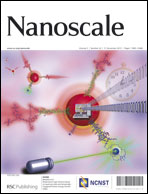CoO–carbon nanofiber networks prepared by electrospinning as binder-free anode materials for lithium-ion batteries with enhanced properties†
Abstract
CoOx–carbon nanofiber networks were prepared from cobalt(II) acetate and polyacrylonitrile by an electrospinning method followed by thermal treatment. The XPS results demonstrated that the cobalt compound in CoOx–carbon obtained at 650 °C was CoO rather than Co or Co3O4. The CoO nanoparticles with diameters of about 8 nm were homogeneously distributed in the matrix of the nanofibers with diameters of 200 nm. As binder-free anodes for lithium-ion batteries, the discharge capacities of such CoO–carbon (CoO–C) composite nanofiber networks increased with the pyrolysis and annealing temperature, and the highest value was 633 mA h g−1 after 52 cycles at a current density of 0.1 A g−1 when the CoO–C was obtained at 650 °C. In addition, the rate capacities of the CoO–C obtained at 650 °C were found to be higher than that of the sample annealed at a lower temperature and pure carbon nanofiber networks annealed at 650 °C. The improved properties of CoO–C nanofiber networks were ascribed to nanofibers as the framework to keep the structural stability, and favorable mass and charge transport. The present study may provide a new strategy for the synthesis of binder-free anodes for lithium-ion batteries with excellent properties.


 Please wait while we load your content...
Please wait while we load your content...